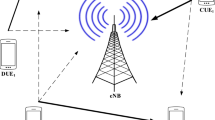Abstract
The fifth-Generation mobile network introduces a new technology called Device-to-device (D2D) Communication which allows User Equipment (UE) to communicate directly with each other, without the need for Base Station or Evolved Node–B (eNB). Thus the mobile data traffic over the eNB can be reduced and throughput can be increased. The objective of this paper is to provide relaying service in cellular network, which has the capability of expanding the network coverage and reducing the traffic over cellular network by using D2D communication. It is achieved by using a technology called Proximity Service (ProSe), in which ProSe Direct Communication and ProSe Direct Discovery enable to identify the UE which are out of network coverage. Then the relay node is selected for serving the UE which are out of network coverage on the basis of Channel Quality Indicator (CQI) and the signal strength between the UE that are in coverage and the UE that are out of network coverage. The UE whose CQI value is high are selected based on certain criteria and are allowed to act as relays. The experiments show that the proposed technique with 5 UERelay maintains the D2D communication for longer period than the traditional techniques. Thus, the UE that are out of network coverage are served for more duration by extending the network coverage of the eNB and by relaying data using D2D offloading.







Similar content being viewed by others
References
Levanen TA, Pirskanen J, Koskela T et al (2020) Radio interface evolution towards 5G and enhanced local area communications. IEEE Access 2:1005–1029
Adedoyin MA, Falowo OE (2020) Combination of ultra-dense networks and other 5G enabling technologies : A survey. IEEE Access 8:22893–22932
Agiwal M, Roy A, Saxena N (2016) Next generation 5G wireless networks: A comprehensive survey. IEEE Commun Surv Tutor 18:1617–1655
Asadi A, Wang Q, Mancuso V (2014) A survey on device-to-device communication in cellular networks. IEEE Commun Surv Tutor 16(4):1801–1819
Jameel F, Hamid Z, Jabeen F et al (2018) A survey of device-to-device communications: Research issues and challenges. IEEE Commun Surv Tutor 20:2133–2168
Ansari RI, Chrysostomou C, Hassan SA et al (2018) 5G D2D Networks: techniques, challenges, and future prospects. IEEE Syst J 12:3970–3984
3GPP TR 22.803 V12.2.0 (2013-06), Feasibility Study for Proximity Services (ProSe), (Release 12)
Gamboa S, Moreaux A, Griffith D et al (2020) UE-to-Network relay discovery in ProSe-enabled LTE Networks, 2020 international conference on computing, networking and Communications (ICNC), Big Island, HI, USA, 871–877
Wang T, Li P, Wang X et al (2019) A Comprehensive Survey on Mobile Data Offloading in Heterogeneous Network. Wirel Netw 25:573–584
Hayat O, Ngah R, Zahedi Y (2019) In-Band Device to Device (D2D) Communication and Device Discovery: A Survey. Wirel Pers Commun 106:451–472
Jayakumar S, Nandakumar S (2020) A review on resource allocation techniques in D2D communication for 5G and B5G technology, Peer-to-Peer Networking and Applications https://doi.org/10.1007/s12083-020-00962-x
Mach P, Becvar Z, Vanek T (2015) In-Band Device-to-Device Communication in OFDMA Cellular Networks: A Survey and Challenges. IEEE Commun Surv Tutor 17:1885–1922
Wang M, Yan Z (2017) A Survey on Security in D2D Communications. Mob Netw Appl 22:195–208
Barik PK, Singhal C, Datta R (2019) DAMS: D2D-assisted multimedia streaming service with minimized BS transmit power in cellular networks. Comput Commun 144:149–161
Alsaba Y, Rahim SKA, Leow CY, Majed MB (2018) On the outage probability of large scale decode-and-forward relay wireless networks. AEU Int J Electron Commun 97:120–129
Zhang Z, Zhang P, Liu D, Sun S (2018) SRSM-based adaptive relay selection for D2D communications. IEEE Int Things J 5:2323–2332
Kar UN, Sanyal DK (2018) An overview of device-to-device communication in cellular networks. ICT Express 4:203–208
Gui J, Deng J (2018) Multi-Hop Relay-Aided Underlay D2D Communications for Improving Cellular Coverage Quality. IEEE Access 6:14318–14338
Moghaddam JZ, Usman M, Granelli F (2018) A Device-to-device communication-based disaster response network. IEEE Trans Cognit Commun Netw 4:288–298
Ebrahimi D, Elbiaze H, Ajib W (2018) Device-to-device data transfer through multihop relay links underlaying cellular networks. IEEE Trans Veh Technol 67:9669–9680
Singh D, Ghosh SC (2019) Mobility-Aware Relay Selection in 5G D2D Communication Using Stochastic Model. IEEE Trans Veh Technol 68:2837–2849
Lucas-Estan MC, Gozalvez J (2019) Mode Selection for 5G Heterogeneous and Opportunistic Networks. IEEE Access 7:113511–113524
Albalawi U (2019) A device-to-device system for safety and emergency services of mobile users. IEEE Consumer Electron Magaz 8:42–45
Balaji CG, AnuMonisha A, Murugan K (2020) A Novel Hybrid UE Selection Scheme for Efficient Data Offloading Using D2D Communication. Comput J 63(10):1513–1523. https://doi.org/10.1093/comjnl/bxaa041
Ghosh A, Ratasuk R (2011) Essentials of LTE and LTE-A, 97–100, The cambridge wireless essentials series. Cambridge University Press, New York
Schlienz J, Roessler A Device to Device Communication in LTE Whitepaper, Rohde & Schwarz, https://www.rohde-schwarz.com/us/applications/device-to-device-communication-in-lte-application-note_56280-142855.html
Lee WJ, Ryu HS, Chung MY (2017) Efficient sidelink re-establishment scheme in device-to-device communications-based public safety networks. Electron Lett 53:354–356
Bletsas A, Shin H, Win MZ (2007) Cooperative communications with outage-optimal opportunistic relaying. IEEE Trans Wirel Commun 6:3450–3460
Acknowledgements
The authors are grateful to the Anna Centenary Research Fellowship (grant no.: CFR/ACRF/2015/42) provided by Centre for Research, Anna University, Chennai–600025 for the support to carry out this research work. The authors also thank the anonymous reviewers who reviewed this article.
Author information
Authors and Affiliations
Corresponding author
Additional information
Publisher’s note
Springer Nature remains neutral with regard to jurisdictional claims in published maps and institutional affiliations.
Rights and permissions
About this article
Cite this article
Balaji, C.G., Murugan, K. Extending the coverage of evolved Node–B by relaying data using device-to-device offloading in next generation cellular network. Peer-to-Peer Netw. Appl. 14, 3820–3830 (2021). https://doi.org/10.1007/s12083-021-01213-3
Received:
Accepted:
Published:
Issue Date:
DOI: https://doi.org/10.1007/s12083-021-01213-3




